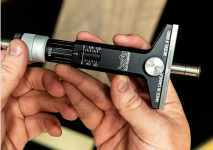Okay, this may be a dumb question.
I'm wondering if anyone has made a cross between a digital caliper and an edge marking device?
Basically if a woodpeckers ruler stop and a thumbwheel digital caliper had a love child. Something that would mark odd measurements like 6.7mm from the edge of a sheet good (don't ask).
Has anyone run across something like this?
I'm wondering if anyone has made a cross between a digital caliper and an edge marking device?
Basically if a woodpeckers ruler stop and a thumbwheel digital caliper had a love child. Something that would mark odd measurements like 6.7mm from the edge of a sheet good (don't ask).
Has anyone run across something like this?

